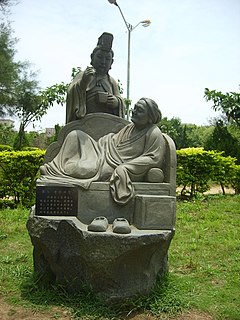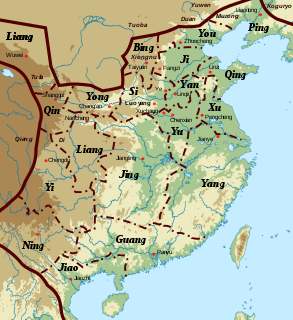The 320s decade ran from January 1, 320, to December 31, 329.

劉 / 刘 is an East Asian surname. pinyin: Liú in Mandarin Chinese, Lau4 in Cantonese. It is the family name of the Han dynasty emperors. The character 劉 originally meant 'kill', but is now used only as a surname. It is listed 252nd in the classic text Hundred Family Surnames. Today, it is the 4th most common surname in Mainland China as well as one of the most common surnames in the world.

Zhao was one of the seven major states during the Warring States period of ancient China. It was created from the three-way Partition of Jin, together with Han and Wei, in the 5th century BC. Zhao gained significant strength from the military reforms initiated during King Wuling's reign, but suffered a crushing defeat at the hands of Qin at the Battle of Changping. Its territory included areas now in modern Inner Mongolia, Hebei, Shanxi and Shaanxi provinces. It bordered the states of Qin, Wei and Yan and various nomadic peoples, including the Hu and Xiongnu. Its capital was Handan, in modern Hebei Province.

Emperor Wen of Han, born Liu Heng, was the fifth emperor of the Western Han dynasty in China from 180 to his death in 157 BCE. The son of Emperor Gao and Consort Bo, his reign provided a much needed stability after the unstable and violent regency of Empress Lü. The prosperous reigns of Wen and his son Emperor Jing are highly regarded by historians, being referred to as the Rule of Wen and Jing.

The Han Zhao, or Former Zhao, was a dynastic state of China ruled by the Xiongnu people during the Sixteen Kingdoms period of Chinese history. In Chinese historiography, it was given two conditional state titles, the Northern Han for the state proclaimed in 304 by Liu Yuan, and the Former Zhao for the state proclaimed in 319 by Liu Yao. The reference to them as separate states should be considered misleading, given that when Liu Yao changed the name of the state from "Han" to "Zhao" in 319, he treated the state as having been continuous from the time that Liu Yuan founded it in 304; instead, he de-established his imperial lineage from the Han dynasty and claimed ancestry directly from Yu the Great of the Xia dynasty.
Taizong is the temple name used for several monarchs of China. It may refer to:
Taizu is a temple name typically, but not always, used for Chinese monarchs who founded a particular dynasty. It may refer to:

After Liu Bang defeated Xiang Yu and proclaimed himself emperor of the Han dynasty, he followed the practice of Xiang Yu and enfeoffed many generals, noblemen, and imperial relatives as kings, the same title borne by the sovereigns of the Shang and Zhou dynasties and by the rulers of the Warring States. Each king had his own semi-autonomous kingdom. This was a departure from the policy of the Qin dynasty, which divided China into commanderies governed by non-hereditary governors.

Empress Dowager Bo (薄太后) was an imperial concubine of Emperor Gaozu of Han. She was also known as Consort Bo (薄姬) during the life of the Emperor, and more formally as either Empress Dowager Xiaowen (孝文太后) or (rarer) Empress Gao (高皇后). Despite being a concubine of lower standing, her son, Liu Heng, became Emperor Wen of Han, cementing her place in history. The year of her birth is not known. She died in 155 BC.
Tuoba Shiyijian was the last prince of the Xianbei-led Dai dynasty of China and ruled from 338 to 376 when Dai was conquered by the Former Qin dynasty. He was the son of Tuoba Yulü and the younger brother of Tuoba Yihuai, whom he succeeded in 338. In 340 he moved the capital to Shengle (盛樂). His grandson Tuoba Gui later founded the Northern Wei dynasty and accorded him the posthumous name Emperor Zhaocheng (昭成皇帝) and the temple name Gaozu (高祖).
Liang was a traditional Chinese fief centered on present-day Kaifeng. It was held by various powers over the course of Chinese history. It generally comprised modern Henan with a small part of Shanxi.
Tuoba Yilu was the chieftain of the western Tuoba territory from 295 to 307, supreme chieftain of the Tuoba from 307 to 316, Duke of Dai from 310 to 315, and first ruler of the Dai kingdom from 315 to 316. He was the son of Tuoba Shamohan (拓跋沙漠汗) and the brother of Tuoba Yituo and Tuoba Fu.
Tuoba Pugen was the chieftain of the central Tuoba territory from 305 to 316, and in 316 ruled as prince of the Tuoba Dai as the supreme chieftain of the Tuoba clan.
Tuoba Yulü ruled as prince of the Tuoba Dai 316 to 321.
Tuoba Yihuai ruled as prince of the Tuoba Dai from 329 to 335 and again from 337 to 338. He was the son of Tuoba Yulü and the nephew of Tuoba Hena. When Tuoba Hena was in his first reign as the Prince of Dai, Tuoba Yihuai lived with his maternal uncle's father Helan Aitou (賀蘭藹頭) of the Helan tribe.
The Sixteen Kingdoms, less commonly the Sixteen States, was a chaotic period in Chinese history from AD 304 to 439 when northern China fragmented into a series of short-lived dynastic states. The majority of these states were founded by the "Five Barbarians", non-Han peoples who had settled in northern and western China during the preceding centuries, and had launched a series of rebellions and invasions against the Western Jin dynasty in the early 4th century. However, several of the states were founded by the Han people, and all of the states—whether ruled by Xiongnu, Xianbei, Di, Jie, Qiang, Han, or others—took on Han-style dynastic names. The states frequently fought against both one another and the Eastern Jin dynasty, which succeeded the Western Jin in 317 and ruled southern China. The period ended with the unification of northern China in 439 by the Northern Wei, a dynasty established by the Xianbei Tuoba clan. This occurred 19 years after the Eastern Jin collapsed in 420, and was replaced by the Liu Song dynasty. Following the unification of the north by Northern Wei, the Northern and Southern dynasties era of Chinese history began.

The military history of the Jin dynasty and the Sixteen Kingdoms encompasses the period of Chinese military activities from 266 AD to 420 AD. The Jin dynasty is usually divided into the Western Jin and Eastern Jin in Chinese historiography. Western Jin lasted from its usurpation of Cao Wei in 266 to 316 when the Uprising of the Five Barbarians split the empire and created a number of barbarian states in the north. The Jin court relocated to Jiankang, starting the era of Eastern Jin, which ended in 420 when it was usurped by Liu Yu, who founded the Liu Song dynasty.

Liang (梁國) was a kingdom/principality in Han dynasty. Its territories was located within the modern Henan, Anhui and Shandong provinces.
Lady Qi, also known as Lady Wei (惟氏), was the wife of Tuoba Yituo and a regent of Dai in the Sixteen Kingdoms period during the minority of her son between 321 and 324. In historical records, she is referred to as Empress Dowager Qi (皇后祁) or Empress Dowager Wei (皇后惟), although during her time, the Tuoba rulers used the title of Prince.
Tuoba Hena ruled as prince of the Tuoba Dai from 325 to 329 and again from 335 to 337. He was the youngest son of Tuoba Yituo and brother of his predecessor, Tuoba Heru.









